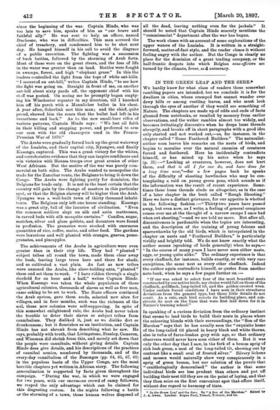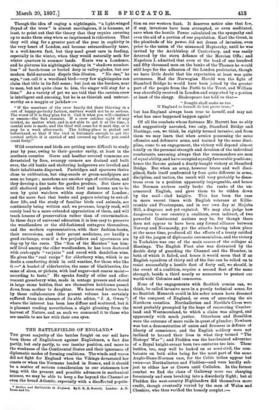IN THE GREEN LEAF AND THE SERE.*
WE hardly know for what class of readers these somewhat rambling papers are intended, but we conclude it is for the
dwellers in cities, whose cramped feet cannot wander over dewy hills or among rustling leaves, and who must look through the eyes of another if they would see something of Nature. The chapters are made up of odds and ends of facts gleaned from notebooks, or recalled by memory from earlier observations, and the writer rambles almost too widely, and becomes irritatingly discursive when he drops loose threads abruptly, and breaks off in short paragraphs with a good idea only started and not worked out,—as, for instance, in the chapter called " Some Feathered Builders." The naturalist- author soon leaves his remarks on the nests of birds, and begins to moralise over the natural enemies of creatures furred and feathered. Here he incidentally contradicts himself, or has mixed up his notes when he says (p. 31) :—" Looking at creatures, however, does not hurt them, and that is all I for one do, and have done for a long time now,"—for a few pages back he speaks of the difficulty of shooting hawfinches who may be con- templating a raid on young green peas, which sounds as if the information was the result of recent experience. Some- times these loose threads elude us altogether, as in the case of a later chapter in the book called " Rough Shooting." Here we have a distinct grievance, for our appetite is whetted in the following fashion :—" Thirty-two years have passed away, but even now, as I write, a feeling of general creepiness comes over me at the thought of a narrow escape I once had when out shooting,"—and we are told no more. But after all, discursiveness is pardonable when the topics are interesting, and the description of the training of young falcons and sparrowhawks by the old birds, which is interpolated in the chapter on nests and " Feathered Builders," is particularly vividly and brightly told. We do not know exactly what the author means (speaking of birds generally) when he says,- " In the course of many years I have never seen either nests. eggs, or young quite alike." The ordinary experience is that every chaffinch, for instance, builds exactly, or with very rare exceptions, the same nest as every other chaffinch. Indeed the author again contradicts himself, or quotes from another note-book, when he says a few pages further on :—
" If one was asked to select four of the most beautiful nests constructed by our native birds, my choice would fall on those of the chaffinch, goldfinch, long-tailed tit, and the golden-crested wren. Under certain forced conditions I have seen in their structures deviations from the general type, but these little details do not count. As a rule, each bird selects its building.place, and con- structs its nest on the lines that were first laid down for it in Nature's training school."
In speaking of a curious deviation from the ordinary instinct that seems to lead birds to build their nests in places where the colouring blends with their surroundings, the " Son of the Marshes " says that he has usually seen the "exquisite home of the long-tailed tit placed in hoary black and white thorns,
also in tufts of furze-bushes grey with age, so that ordinary observers would never have seen either of them. But it was
only the other day that I saw, in the fork of a broom sprig of rich lush green, a nest of the long-tailed tit, showing out by contrast like a small oval of frosted silver." Silvery lichens and mosses would naturally show very conspicuously in a sprig of green broom, but our solution of the puzzle that " ornithologically demoralised " the author is that some individual birds are less prudent than others and put off building their nest till they are on the point of laying, and that they then seize on the first convenient spot that offers itself, without due regard to harmony of tints.
• In the Green Eta./ and th. R.rs. Ry " A Bon of the Maeshee." Edited by J. L. Owen. London: Began Paul, Trench, Trtincer, and Co.
Though the idea of caging a nightingale, "a light-winged Dryad of the trees" is almost sacrilegious, it is humane, at least, to point out that the theory that they require covering up to make them sing when so imprisoned is ridiculous. That they will sing for a greater part of the year in captivity in the very heart of London, and become extraordinarily tame, is a well-known fact, but they need great care in feeding, especially in the winter, when they would naturally seek for winter quarters in summer lands. Keats was a Londoner, and he pictures his nightingale singing in "shadows number- less " of beech-trees or buried deep in valley-glades, but our
modern field-naturalist dispels this illusion. " No one," he
says, "can call it a woodland bird—very few nightingales can claim that title in its fall sense; but just on the borders, near to man, but not quite close to him, the singer will stay for a time." As a variety of pet we are told that the carrion-crow is intelligent and amusing, but he is as thievish and untrust- worthy as a magpie or jackdaw :-
" If the members of the crow family did their thieving in a sort of happy-go-lucky fashion, matters would not be so serious. The worst of it is they plan for it. Call it what you will—instinct or reason—the fact remains. If a crow catches sight of any trinket, no matter what, and is not able to get it at the time, a mental note is made, and the thief will come for it next day, or it may be a week afterwards. The hiding-place is picked out beforehand, so that if the bird is fortunate enough to get the coveted article it is carried of and covered up before you could count forty."
Wild creatures and birds are getting more difficult to study year by year, owing to their• greater rarity, at least in the southern counties Gorse and heather covered commons are devastated by fires, swampy corners are drained and built over, the old banks and sheltering hedgerows are levelled and their inhabitants dispersed. Partridges and sparrows thrive close to cultivation, but ring-ouzels or green-sandpipers are seen no longer ; moorhens are another sign of cultivation, and they develop a fine taste for garden produce. But there are still sheltered ponds where wild fowl and herons are to be seen by quiet watchers within easy distance of London ; and the mere fact that books and papers relating to out-of- door life, and the study of familiar birds and animals, are continually being written and, we presume, largely read, will surely lead to a more extended appreciation of them, and will teach lessons of preservation rather than of extermination.
In these days of universal education it is less easy to preserve the woodlanders or the old-fashioned cottagers themselves, and the modern representatives, with their fashion-books, their excursions, and their patent medicines, are hardly a good exchange, even if a few prejudices and iguorances are dug up by the roots. The "Son of the Marshes " has him- self lived among the older woodlanders, he has been doctored with crab-apple " varjuice " and cured with dandelion wine.
He gives the " real recipe " for elderberry wine, which is no doubt a comforting drink in cold weather, for those who like it :—" A bushel of elderberries, the same of blackberries, the same of sloes, or pickets, with loaf sugar—not coarse moist— according to taste." He speaks fondly of cider and effer- vescent gooseberry wine, made in cottage presses and stored in large stone bottles, that are themselves heirlooms passed down from mother to daughter. We have read better books by these collaborators (the present volume has certainly suffered from the absence of its able editor, "J. A. Owen ") where the interest has been less diffuse and scattered, but it is pleasant reading nevertheless, a slight gleaning from the harvest of Nature, and as such we commend it to those who are unable to see her with their own eyes.







































 Previous page
Previous page